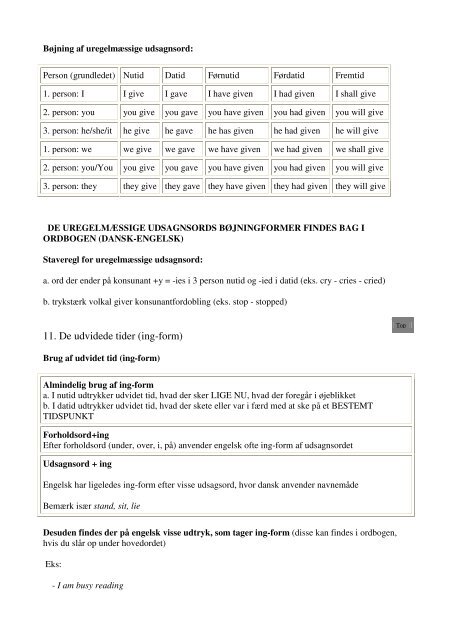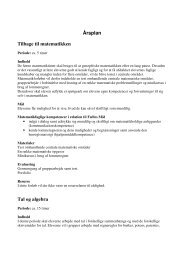Denne side er bygget op efter vores arbejdsbog The New ... - Flexiweb
Denne side er bygget op efter vores arbejdsbog The New ... - Flexiweb
Denne side er bygget op efter vores arbejdsbog The New ... - Flexiweb
Create successful ePaper yourself
Turn your PDF publications into a flip-book with our unique Google optimized e-Paper software.
Bøjning af uregelmæssige udsagnsord:<br />
P<strong>er</strong>son (grundledet) Nutid Datid Førnutid Førdatid Fremtid<br />
1. p<strong>er</strong>son: I I give I gave I have given I had given I shall give<br />
2. p<strong>er</strong>son: you you give you gave you have given you had given you will give<br />
3. p<strong>er</strong>son: he/she/it he give he gave he has given he had given he will give<br />
1. p<strong>er</strong>son: we we give we gave we have given we had given we shall give<br />
2. p<strong>er</strong>son: you/You you give you gave you have given you had given you will give<br />
3. p<strong>er</strong>son: they they give they gave they have given they had given they will give<br />
DE UREGELMÆSSIGE UDSAGNSORDS BØJNINGFORMER FINDES BAG I<br />
ORDBOGEN (DANSK-ENGELSK)<br />
Stav<strong>er</strong>egl for uregelmæssige udsagnsord:<br />
a. ord d<strong>er</strong> end<strong>er</strong> på konsunant +y = -ies i 3 p<strong>er</strong>son nutid og -ied i datid (eks. cry - cries - cried)<br />
b. trykstærk volkal giv<strong>er</strong> konsunantfordobling (eks. st<strong>op</strong> - st<strong>op</strong>ped)<br />
11. De udvidede tid<strong>er</strong> (ing-form)<br />
Brug af udvidet tid (ing-form)<br />
Almindelig brug af ing-form<br />
a. I nutid udtrykk<strong>er</strong> udvidet tid, hvad d<strong>er</strong> sk<strong>er</strong> LIGE NU, hvad d<strong>er</strong> foregår i øjeblikket<br />
b. I datid udtrykk<strong>er</strong> udvidet tid, hvad d<strong>er</strong> skete ell<strong>er</strong> var i færd med at ske på et BESTEMT<br />
TIDSPUNKT<br />
Forholdsord+ing<br />
Eft<strong>er</strong> forholdsord (und<strong>er</strong>, ov<strong>er</strong>, i, på) anvend<strong>er</strong> engelsk ofte ing-form af udsagnsordet<br />
Udsagnsord + ing<br />
Engelsk har ligeledes ing-form eft<strong>er</strong> visse udsagsord, hvor dansk anvend<strong>er</strong> navnemåde<br />
Bemærk især stand, sit, lie<br />
Desuden findes d<strong>er</strong> på engelsk visse udtryk, som tag<strong>er</strong> ing-form (disse kan findes i ordbogen,<br />
hvis du slår <strong>op</strong> und<strong>er</strong> hovedordet)<br />
Eks:<br />
- I am busy reading<br />
T<strong>op</strong>



